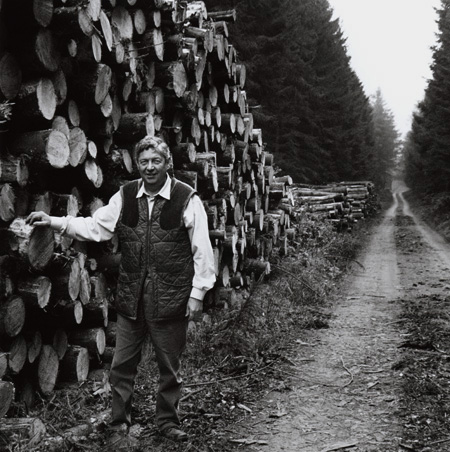| The
whole eastern side of Brown Clee has been well-wooded since the 1850s,
when Lord Boyne’s family first bought the estate. The forest used
to go right up to the quarries at the top – but forestry isn’t
viable up there, it’s too high and exposed.
So we moved the forest down the hill a stage during and after the Second
World War. That was
when some of the older stands of broadleaved trees lower down the hill
became incorporated into the forest.
Most of the pools in the woods were created for ornamental reasons,
and to create employment for local people – estates used to do
that in the 19th century. Of course labour was very, very cheap in those
days. There are still parts of a Second World War bomber in one of these
pools, Boyne Water. There’s an aerial photograph taken in the
mid-1970s, which shows the skid marks where the plane hit the ground
before going into the pool. The ground obviously took a long time to
heal over.
A few years ago we cleaned the pool out and refilled it, and we found
bits of metal in there. But the engine is still in the pool –
they tell us it was never dredged out. It must be buried deep, we didn't
see it.
We clear-fell an area of woodland every year, and we thin the woodlands
out every year, all year. You remove the smaller trees to allow the
better ones to grow on. We fell around 7,500 trees a year, but I am
also planting nearly 30,000 this year. Clear-felling is all mechanised
nowadays. Harvester machines grab the tree, slice it off and cut it
into required lengths, before stacking the timber on the side of the
path to be loaded onto lorries. We only hand-fell trees that are too
big for the harvester to grab, or when you are thinning an area.
When you clear-fell an area of conifers, it can look very bare, there’s
very little undergrowth. But as soon as you let the light in, it soon
explodes again, and all those seeds that have lain dormant for the best
part of 30 years just come up. You’ll get some conifer seeds;
but you get all the other things as well – foxgloves, gorse, briars,
bramble and finer grasses.
We aren’t over-commercial. We keep and plant a lot of broadleaved
trees for landscape interest, and we open up views for walkers. We are
generally happy for walkers to go wherever they want, as long as they
are causing no damage. I just wave and say ‘Good morning’.
If they were lighting a fire it would be a different matter. People
do occasionally camp on the hill without permission – I come across
their campfires.
There haven't been great changes to the quarry buildings in my time
here, which is nearly 30 years. But we did make some of them safer by
capping a few walls that were loose. The biggest difference is the new
communication tower on Abdon Burf. One of the masts is owned by BT and
the other one by the Home Office.
It’s very satisfying to be able to mould the landscape the way
we do. I feel quite at home in the woods, much less threatened there
in the middle of the night than I would in the middle of Birmingham.
As for the other Clee Hill, I have been up Titterstone – but very
rarely. It’s a very different sort of hill, much more open, more
rugged and wild. I think the people are quite different too. More independent,
much more likely to settle grievances on their own account. Brown Clee
is more an entity; all the eastern slope is under one ownership. Over
there it’s fragmented, and I think it feels like it. |
